Concerning Conversation With DB Electrical
Re: Concerning Conversation With DB Electrical
|
Administrator
|
Damn Rusty, It has been so long since I had a vehicle with a dynamo (generator) that I had forgotten about Ford's temperature compensated voltage regulators. Last car I had with one of those was my 1964 Falcon.
Bill AKA "LOBO" Profile
"Getting old is inevitable, growing up is optional" Darth Vader 1986 F350 460 converted to MAF/SEFI, E4OD 12X3 1/2 rear brakes, traction loc 3:55 gear, 160 amp 3G alternator Wife's 2011 Flex Limited Daily Driver 2009 Flex Limited with factory tow package Project car 1986 Chrysler LeBaron convertible 2.2L Turbo II, modified A413 |
|
In reply to this post by Gary Lewis
Correct, varying the Voltage will change the current. With solenoids like used on old external regulators you would have to vary the voltage to get a current change. With solid state such as used in modern regulators I would have thought the ability to just control the current while maintaining voltage would have been a possibility. I mean now the most modern alternators uses clutches in the pulley where the computer actually reduces the alternator output to nothing once the battery is fully charged.
"Old Blue" - '56 Fairlane Town Sedan - 292-4V, Ford-O-Matic transmission, 3.22:1
'63 Belair 2dr sdn - 283-4V, Powerglide transmission, 4.56:1 '78 Cougar XR7 - 351-2V, FMX transmission, 2.75:1 9inch "Bruno" - '82 F150 Flareside - 302-2V, C6 transmission, 2.75:1 9inch, 31x10.50-15 BFG KO2 |
|
In reply to this post by 85lebaront2
Yep and for me for my '56 its a pain trying to find all those specific tools such as the temperature probe for the regulator. But eventually I think I will find one popping up on ebay like I found a set of 5 NOS stainless steel beauty rings after about four years. But on the talk of the modern alternators, I know the real modern ones dont sense voltage and charge, they are excited by the computer itself to maintain voltage. Some have also gone so far to use a clutch on the alternator pulley where they will actually disconnect the alternator from the pulley once the battery is charged up. With that kind of operation, I would have thought the 3G`s would have been varying amperage output but maintaining voltage to the regulator preset. It looks like what's been posted that the 3G still operates like the old temperature compensated voltage regulators from 50 years ago and vary the voltage to vary the amperage. Going to be fun to see how my 3G does with its soft start regulator with its 14.6 volt set point and if it actually varies like other 3G regulators or not.
"Old Blue" - '56 Fairlane Town Sedan - 292-4V, Ford-O-Matic transmission, 3.22:1
'63 Belair 2dr sdn - 283-4V, Powerglide transmission, 4.56:1 '78 Cougar XR7 - 351-2V, FMX transmission, 2.75:1 9inch "Bruno" - '82 F150 Flareside - 302-2V, C6 transmission, 2.75:1 9inch, 31x10.50-15 BFG KO2 |
Re: Concerning Conversation With DB Electrical
|
Administrator
|
In reply to this post by Lima Delta
Jim - I misunderstood. And I see what you mean. Yes, I don't know that I have an alternator cooling problem. But I now see that the alternator sits directly behind the tip of the fan blades, which is where most of the air from the radiator comes through. So it is getting hit with the hot air from the radiator and that is probably what is causing the set point to come down earlier and farther than I would have expected.
Was talking to my nephew about this yesterday and he agreed with my assessment and was intrigued with my idea of creating a cover for the front of the alternator that just has enough room at the 3:00 position to let the belt in, but has a fitting for an air duct at the 9:00 position. That way the alternator could pull cool air from in front of the radiator and be shielded from the hot radiator air. Lucas - Thanks for the input on the 3G page. You are seeing exactly what I saw when I went back to look at it - confusion. It really needs to be cleaned up and organized - especially in the "choosing an alternator" area. And I hope your DB alternator works out good for you. Please let us know.
Gary, AKA "Gary fellow": Profile
Dad's: '81 F150 Ranger XLT 4x4: Down for restomod: Full-roller "stroked 351M" w/Trick Flow heads & intake, EEC-V SEFI/E4OD/3.50 gears w/Kevlar clutches
|
Re: Concerning Conversation With DB Electrical
|
Administrator
|
Gary, I don't know if I would try to create a cover or plenum for the alternator to run in.
Again, only theory, but I would feel the alternator needs to draw from all sides without restriction that would cause lower pressure (and therefore less density able to carry heat away) The one certainty is that fully loaded the alternator is on the edge of it's ability to cool itself. Perhaps a wing or panel to try and divert air coming off the fan towards the block? Or the end of that duct acting as above without fitting closely? (an inch or more in front of the belt) That big clutch fan not only draws huge volume through the radiator (when the clutch is heated to lockup) but it also stirs it all together, so when the AC condenser is operating it's going to be hotter than one might expect.
Jim,
Lil'Red is a '87 F250 HD, 4.10's, 1356 4x4, Zf-5, 3G, PMGR, Saginaw PS, desmogged with a Holley 80508 and Performer intake. Too much other stuff to mention. |
Re: Concerning Conversation With DB Electrical
|
Administrator
|
You are right, any cover would have to be fairly "loose" to ensure air can get to all of the inlets of the alternator. If it was very tight then only the inlets on the side where the "cold" air comes in would get air. But it could still have a tab that comes down between the belt runs to keep as much hot air from coming in there as is possible.
And yes, this is theory. But you are also right that a fully-loaded alternator is on the edge, so providing it with much cooler air would be a big benefit. And, as you point out, the air from the radiator and A/C system combined are HOT. Yesterday as we were testing it was only in the 90's outside, but the heat coming out of the engine compartment was blistering. My nephew said he's recently worked on two different Porsche 911's, one of which has an air-cooled alternator and the other a liquid-cooled alternator. But even the air-cooled one is on a liquid-cooled stand so you have to drain the coolant just to remove the alternator! Anyway, the OEMs are finding that alternator cooling is needed on the high-output units. So maybe I should supply some cool air to mine if I go to a high-output unit.
Gary, AKA "Gary fellow": Profile
Dad's: '81 F150 Ranger XLT 4x4: Down for restomod: Full-roller "stroked 351M" w/Trick Flow heads & intake, EEC-V SEFI/E4OD/3.50 gears w/Kevlar clutches
|
Re: Concerning Conversation With DB Electrical
|
Administrator
|
In reply to this post by Rusty_S85
You might look for an infrared thermometer, they are pretty accurate and work well on a black target. We used them at the shipyard for all sorts of things.
Bill AKA "LOBO" Profile
"Getting old is inevitable, growing up is optional" Darth Vader 1986 F350 460 converted to MAF/SEFI, E4OD 12X3 1/2 rear brakes, traction loc 3:55 gear, 160 amp 3G alternator Wife's 2011 Flex Limited Daily Driver 2009 Flex Limited with factory tow package Project car 1986 Chrysler LeBaron convertible 2.2L Turbo II, modified A413 |
Re: Concerning Conversation With DB Electrical
|
Administrator
|
In reply to this post by Rusty_S85
Rusty - Please post the part # and manufacturer of your regulator. I suspect that there are regulators out there that have different temp curves, so it would be interesting to compare.
Gary, AKA "Gary fellow": Profile
Dad's: '81 F150 Ranger XLT 4x4: Down for restomod: Full-roller "stroked 351M" w/Trick Flow heads & intake, EEC-V SEFI/E4OD/3.50 gears w/Kevlar clutches
|
Re: Concerning Conversation With DB Electrical
|
Administrator
|
In reply to this post by 85lebaront2
Most IR thermometers these days have emissivity settings.
I personally hate both black *and* chrome. If I have a choice I'll apply a patch of plain tan masking tape as a target. If you want to read the air coming out the radiator or alternator (which is what we're really interested in) you're likely to use the thermocouple that came with your DVOM.
Jim,
Lil'Red is a '87 F250 HD, 4.10's, 1356 4x4, Zf-5, 3G, PMGR, Saginaw PS, desmogged with a Holley 80508 and Performer intake. Too much other stuff to mention. |
Re: Concerning Conversation With DB Electrical
|
Administrator
|
I was just thinking the same thing. I have a thermocouple for my DVOM and could easily test. But, with the hood open and sitting still the test wouldn't be as valid. So I'd need to extend the leads and put the DVOM in the cab to see what the inlet air temp to the alternator is. But that would be easy enough. On the other hand, if I'm running the winch I'll probably have the hood closed and effectively be sitting still. So maybe that's worst case and I could easily shut the hood to run that test. Then put the "hood" on the alternator and see how much it changes. That would prove whether the alternator can pull its own air effectively through the radiator support, short piece of hose, and the hood. 
Gary, AKA "Gary fellow": Profile
Dad's: '81 F150 Ranger XLT 4x4: Down for restomod: Full-roller "stroked 351M" w/Trick Flow heads & intake, EEC-V SEFI/E4OD/3.50 gears w/Kevlar clutches
|
Re: Concerning Conversation With DB Electrical
|
Administrator
|
Be mindful that you can't just use any kind of wire to extend a thermocouple, and depending on how critical that measurement is you might have to incorporate a correction factor.
I'm not the metrology wiz that Bill is but I do remember these things back when Omega Engineering was a fairly big operation here in Stamford.
Jim,
Lil'Red is a '87 F250 HD, 4.10's, 1356 4x4, Zf-5, 3G, PMGR, Saginaw PS, desmogged with a Holley 80508 and Performer intake. Too much other stuff to mention. |
Re: Concerning Conversation With DB Electrical
|
Administrator
|
Yes, Jim you are correct. You need the same wire the thermocouple is made from and you need the proper plug sets (made with the same metals) for extensions. Somewhere in here, I have a pair of thermocouple readouts that were "surplus" before I retired.
The reason I mentioned using an infrared sensor to Rusty, they are great for measuring temperatures on objects, in his case a generator regulator as Ford's were temperature compensated.
Bill AKA "LOBO" Profile
"Getting old is inevitable, growing up is optional" Darth Vader 1986 F350 460 converted to MAF/SEFI, E4OD 12X3 1/2 rear brakes, traction loc 3:55 gear, 160 amp 3G alternator Wife's 2011 Flex Limited Daily Driver 2009 Flex Limited with factory tow package Project car 1986 Chrysler LeBaron convertible 2.2L Turbo II, modified A413 |
Re: Concerning Conversation With DB Electrical
|
Administrator
|
I assumed that the thermocouple was just at the end of the wire and I could extend it with copper. Duh! Glad you mentioned that.
I'm working on a CAD (cardboard-aided design) for what I'm thinking about...
Gary, AKA "Gary fellow": Profile
Dad's: '81 F150 Ranger XLT 4x4: Down for restomod: Full-roller "stroked 351M" w/Trick Flow heads & intake, EEC-V SEFI/E4OD/3.50 gears w/Kevlar clutches
|
Re: Concerning Conversation With DB Electrical
|
Administrator
|
This post was updated on .
Just for the heck of it, I looked at the alternator for the Flex. It has axial mounts like a 3G for a 460 or Taurus, but would need the rear case clocked 120° to put the terminals in an accessible position, pulley takes a 6 rib polygroove belt same as the existing ones, just looks like a smaller pulley.
The ears are not 180° apart though. Issue would be whether there is either a way to "cheat" the regulator or used the EEC-V to control it. I have done that sort of CAD work also. Here is a current version, head gasket comparison for Chrysler 4 cyl engines which fortunately use the same size (11 mm) fasteners and pattern.  Notes: B = bolt hole OS = oil supply OD = oil drain W = small water passages arrow is toward the "front" of the engine For the red gasket outline, that one matches the block and manifolds are like a 300 and both on the back side. Green and blue are DOHC cross flow, intake in front exhaust on the back.
Bill AKA "LOBO" Profile
"Getting old is inevitable, growing up is optional" Darth Vader 1986 F350 460 converted to MAF/SEFI, E4OD 12X3 1/2 rear brakes, traction loc 3:55 gear, 160 amp 3G alternator Wife's 2011 Flex Limited Daily Driver 2009 Flex Limited with factory tow package Project car 1986 Chrysler LeBaron convertible 2.2L Turbo II, modified A413 |
I dont think heat would be a problem, have to remember the cars and trucks these 3G alternators were installed on were a lot more cramped with way higher under hood temperatures than our trucks would ever consider having with how much room under the hood we have. Thats what I thought of doing, still I would love to have the old tools even if I dont use them just as a collectible to go with the car. Regulator I bought has a part number of GR-818 on the box and the regulator itself has a part number of F5RU-10316-BA and its a new Motorcraft made regulator. I tried looking information up on it and all I could ever find was from Manic Electric Motors where they state its a Ford 3G series IR/IF alternators with a 12V spec, A-Circuit, I-S-A Terminal, 14.6 Voltage Set Point, w/ LRC, White and that its application is 1995 - 2000 Ford, 1993 - 2002 Ford Europe, and 1995 - 2001 Mercury. I would be interested in seeing what the temp curve would be if there is any difference. I am also curious in difference from our trucks to late model vehicles that had the 3Gs from the factory. I know my truck currently with the OE engine has hardly any heat under the hood when running and even with the fan pulling air off the radiator the air is not that hot even with a 180* thermostat. Yet late model vehicles at work seem to always have super heated air under the hood and when the fans are pulling air through the radiator the air feels like a blast furnace. I do kind of wonder if going back to a 195* thermostat on my truck if it would result in that big of a chance in under hood temps and air coming off the radiator itself. Its a shame no one ever came up with an idea for stealing GMs idea with the crank pulley using one multi rib belt for just the alternator and retaining OE V belts else where. Its something I played around with and wondered if I could fit a narrow multi rib belt between the V belts and my bolt on dealer A/C V belt. I really dont want to change everything over to serpentine belt on my truck just from a cost stand point but I also hate the idea of slippage with just one V belt hence why I bought a NOS Motorcraft 3G regulator with the soft start regulator with hopes it wont slip on me. Only other thing is if I can get a wrench on the alternator good enough to tension the alternator belt tight enough to walk on. I dont have to worry about wiping out a water pump since the alternator on our trucks run off the crank pulley only.
"Old Blue" - '56 Fairlane Town Sedan - 292-4V, Ford-O-Matic transmission, 3.22:1
'63 Belair 2dr sdn - 283-4V, Powerglide transmission, 4.56:1 '78 Cougar XR7 - 351-2V, FMX transmission, 2.75:1 9inch "Bruno" - '82 F150 Flareside - 302-2V, C6 transmission, 2.75:1 9inch, 31x10.50-15 BFG KO2 |
Re: Concerning Conversation With DB Electrical
|
Administrator
|
Bill - I'm not sure I understand the conclusions you are drawing from the CAD work. (Get it? Drawing CAD
 ) )
Rusty - My regulators are from National Quick Start and are "F795 - Voltage Regulator, 12 Volt, A-Circuit, I-S-A Terminals, 14.6 Vset, 2.5 second LRC, For Ford 3G Series Alternators" and the sister - F794 that is the same but w/o LRC. And despite the 14.6 volt set point I never see higher than about 14.3 - although I will admit I've not checked at 0F, and given the temp curve I posted previously maybe that's where the 14.6 happens. Also, I'm not saying heat is a "problem" right now. Just that I think it is what is causing the voltage set point to come down. I've not checked the air temp off the radiator on Big Blue, but it is surely in excess of 200F as the ambient is in the high 90's right now and the discharge air is HOT. And I'm running a 180F 'stat. And the tip of the fan, where the most of the air is coming from, is almost perfectly lined up with the pulley of the alternator. So the fan is blowing that really hot air directly into the alternator. However, I think if I put a 220 amp 3G in that the heat may well be a problem. And that's why I'm working on a design to get "cold" air to the alternator. (Next post.)
Gary, AKA "Gary fellow": Profile
Dad's: '81 F150 Ranger XLT 4x4: Down for restomod: Full-roller "stroked 351M" w/Trick Flow heads & intake, EEC-V SEFI/E4OD/3.50 gears w/Kevlar clutches
|
Re: Concerning Conversation With DB Electrical
|
Administrator
|
Ok, here's my CAD & hacksaw results. I think it would be made out of sheetmetal and would be held in place by replacing the pivot and clamp bolts with studs with nuts welded to them to allow tightening, but with a stub sticking out to go through the "bonnet" as I'm calling it.
But this bonnet is a bit small as it isn't big enough to allow the clamp bolt/stud to come through. And, it doesn't fully cover the front of the alternator. Having said that, I don't know if the slots are inlets or outlets, so I may spin my spare alternator up in the lathe and see. Here are a bunch of pics, but I'd really like your input. PLEASE! 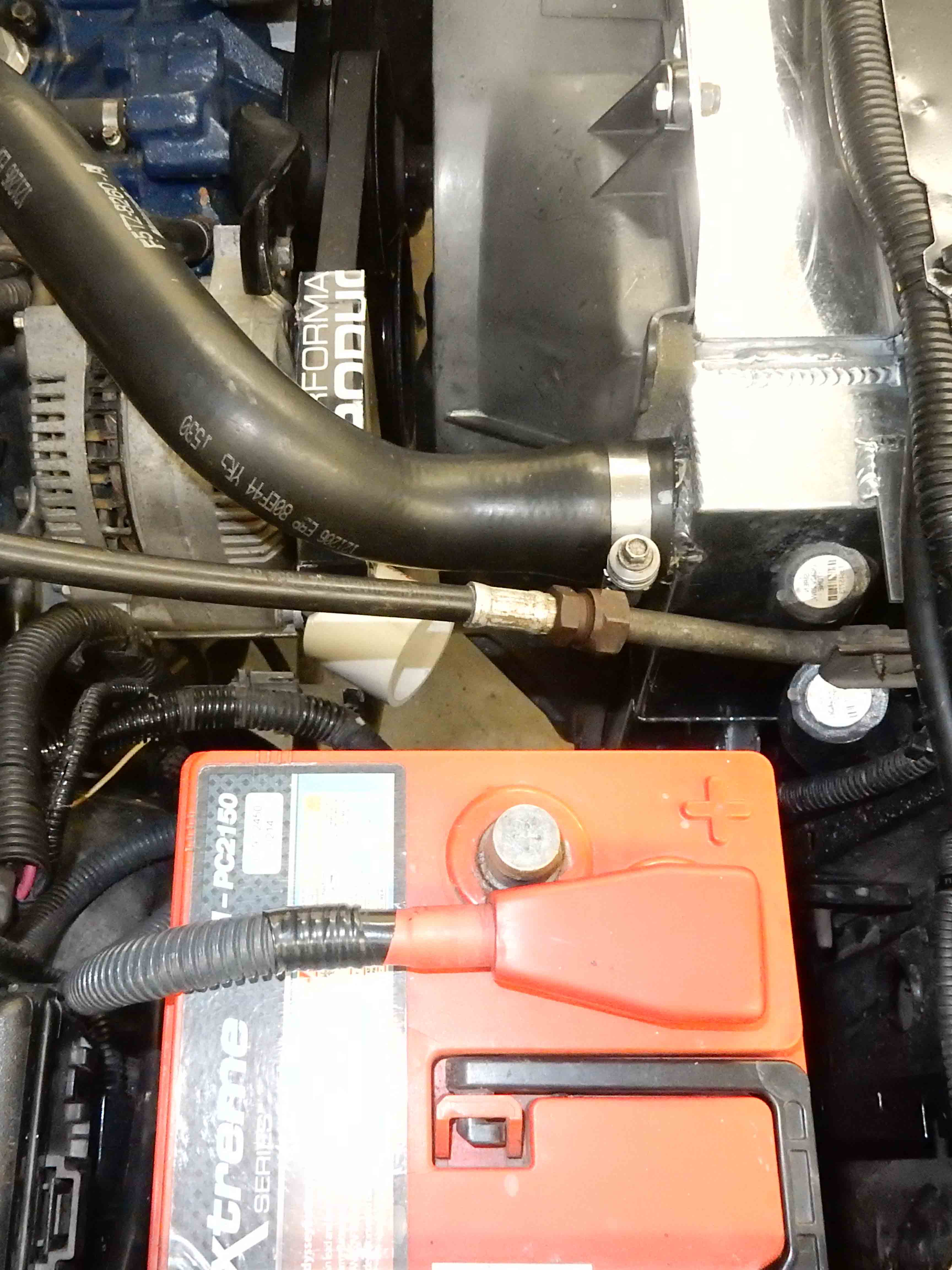 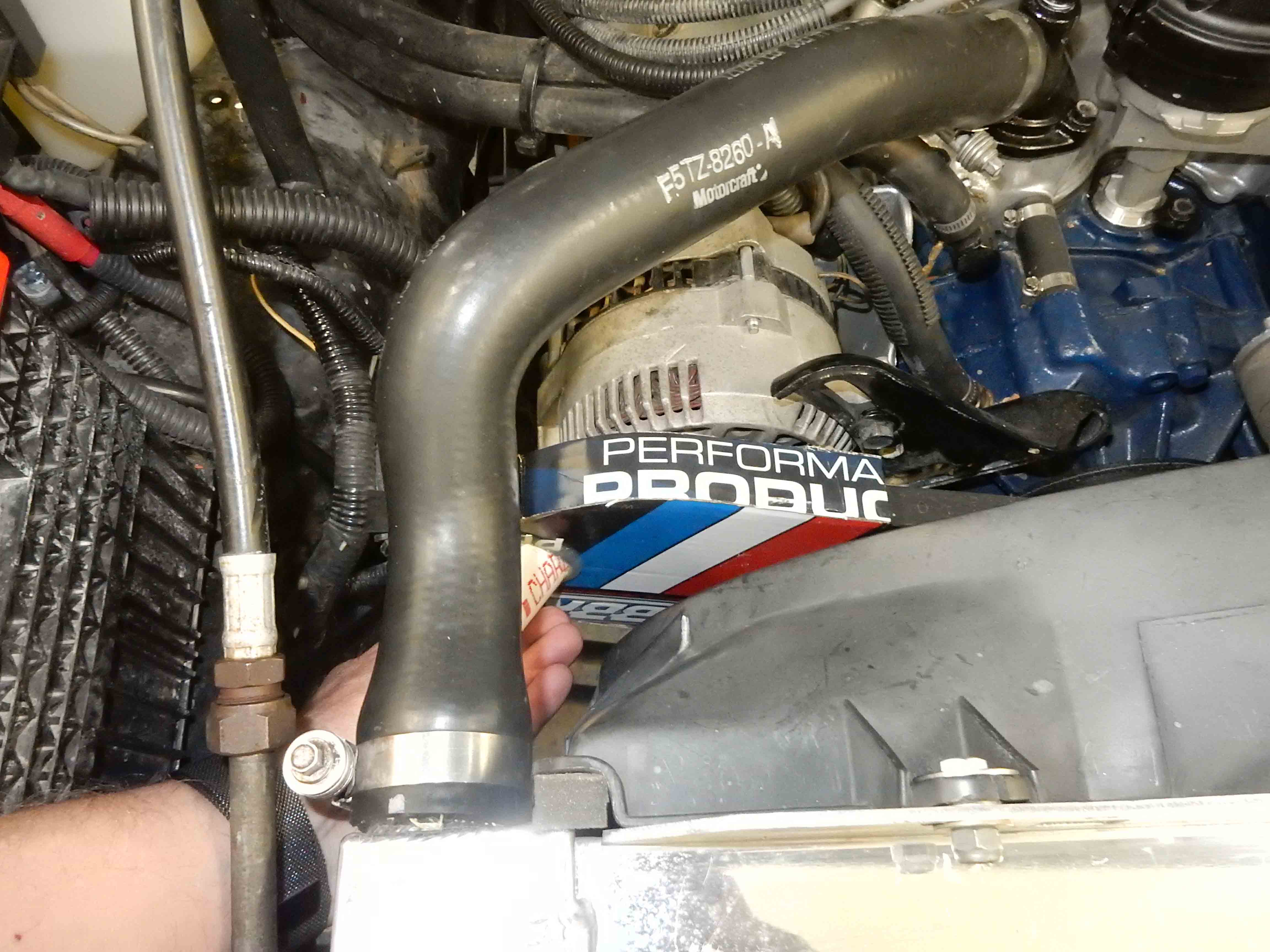 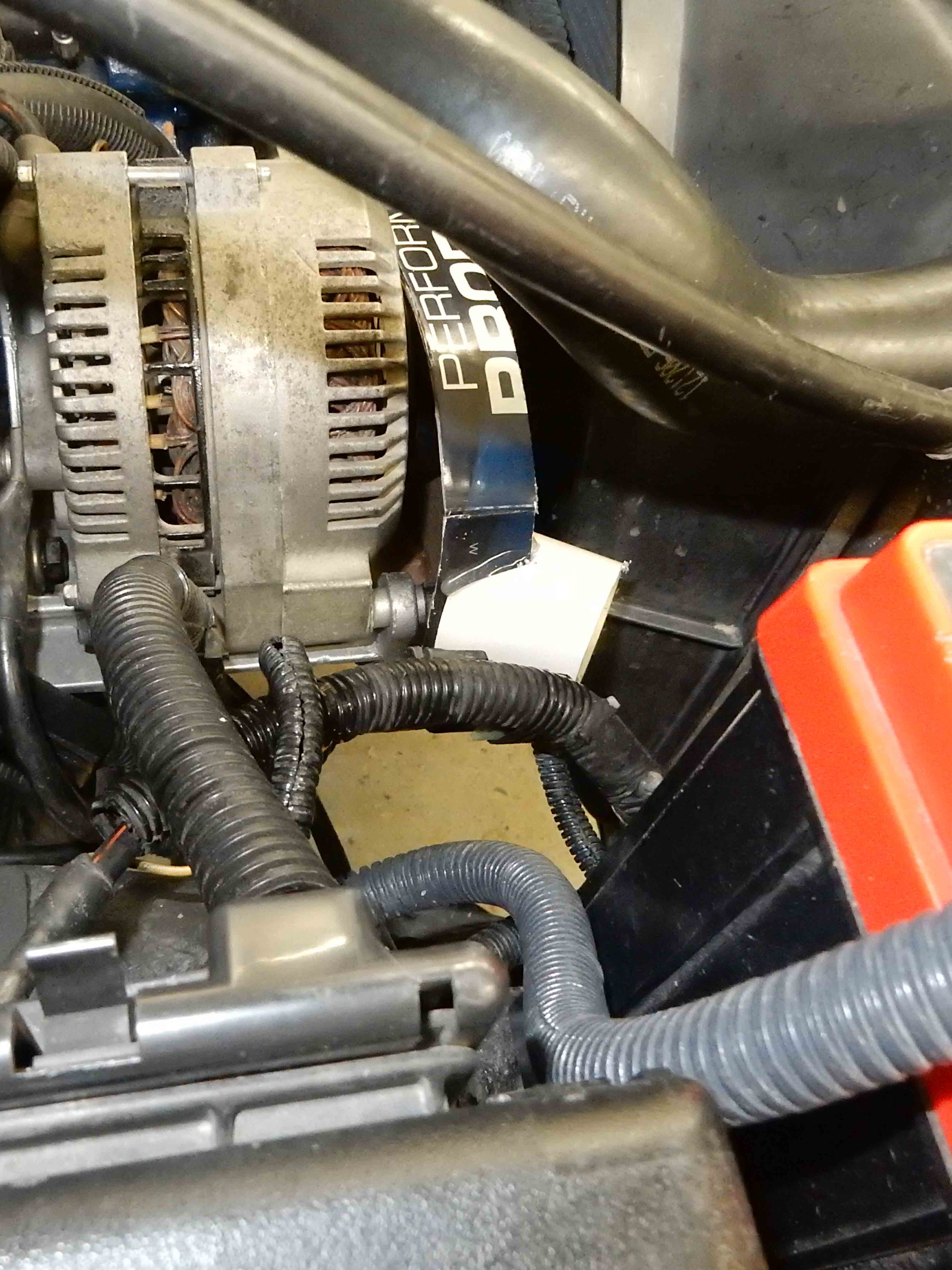 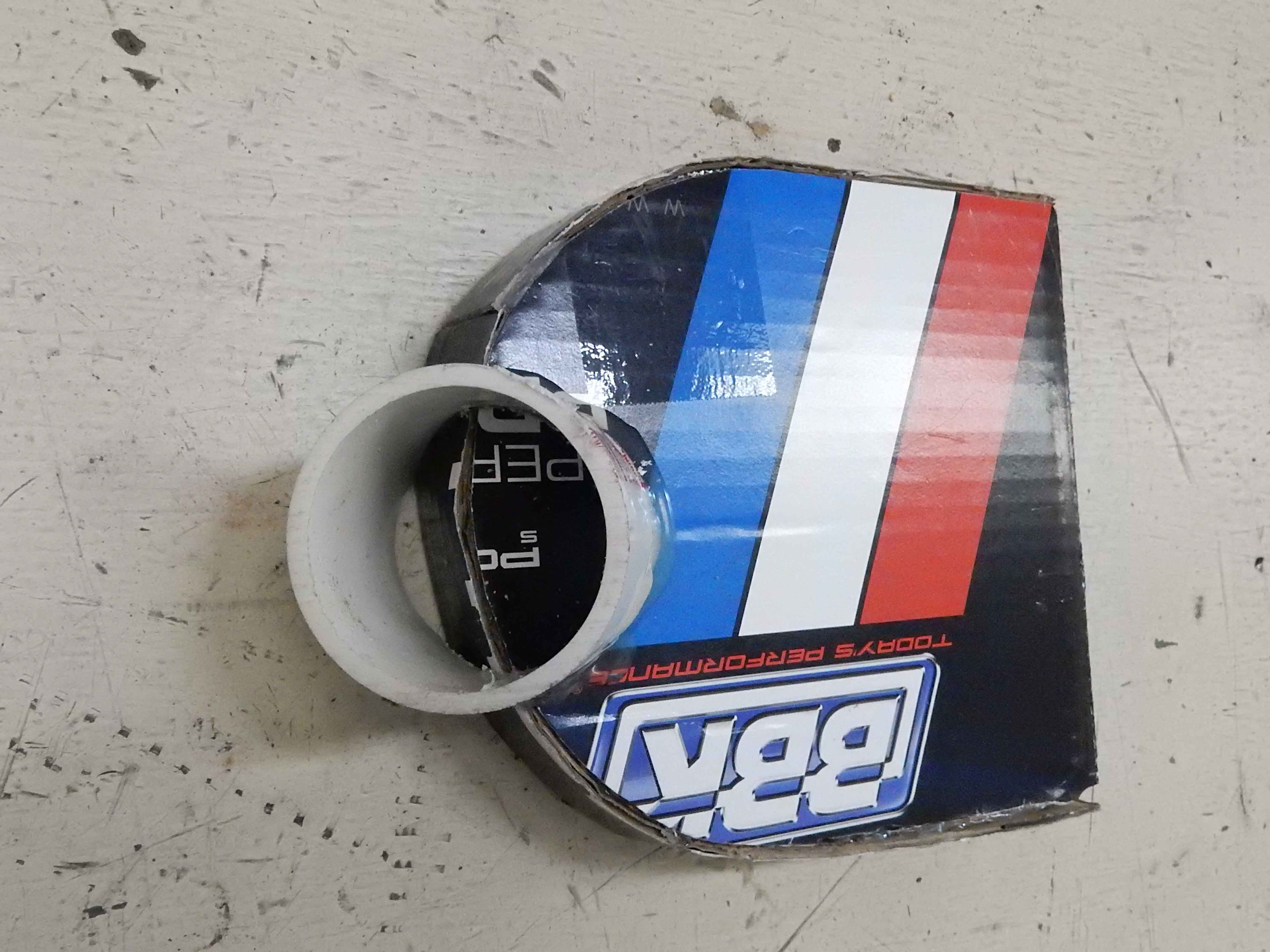 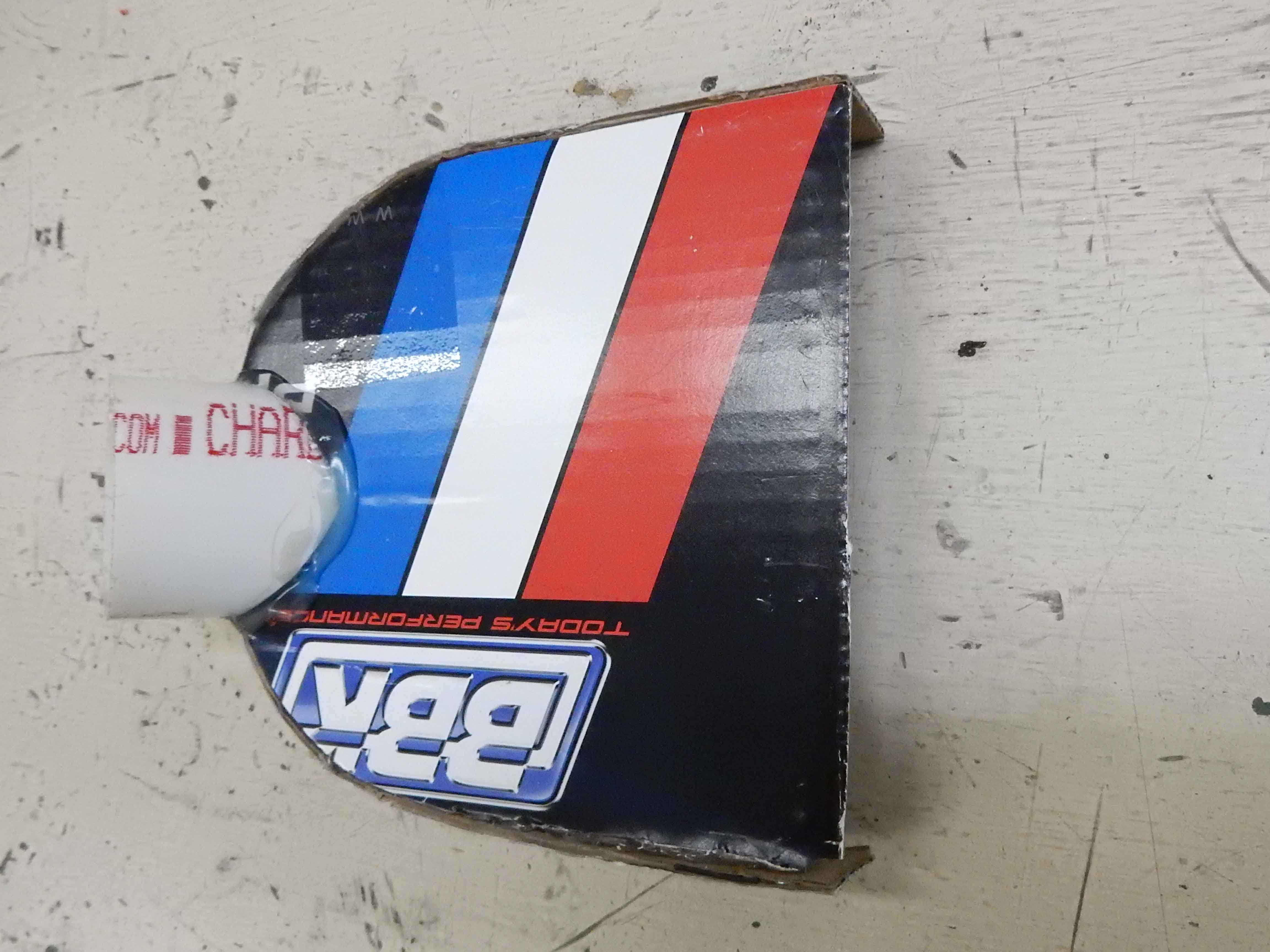 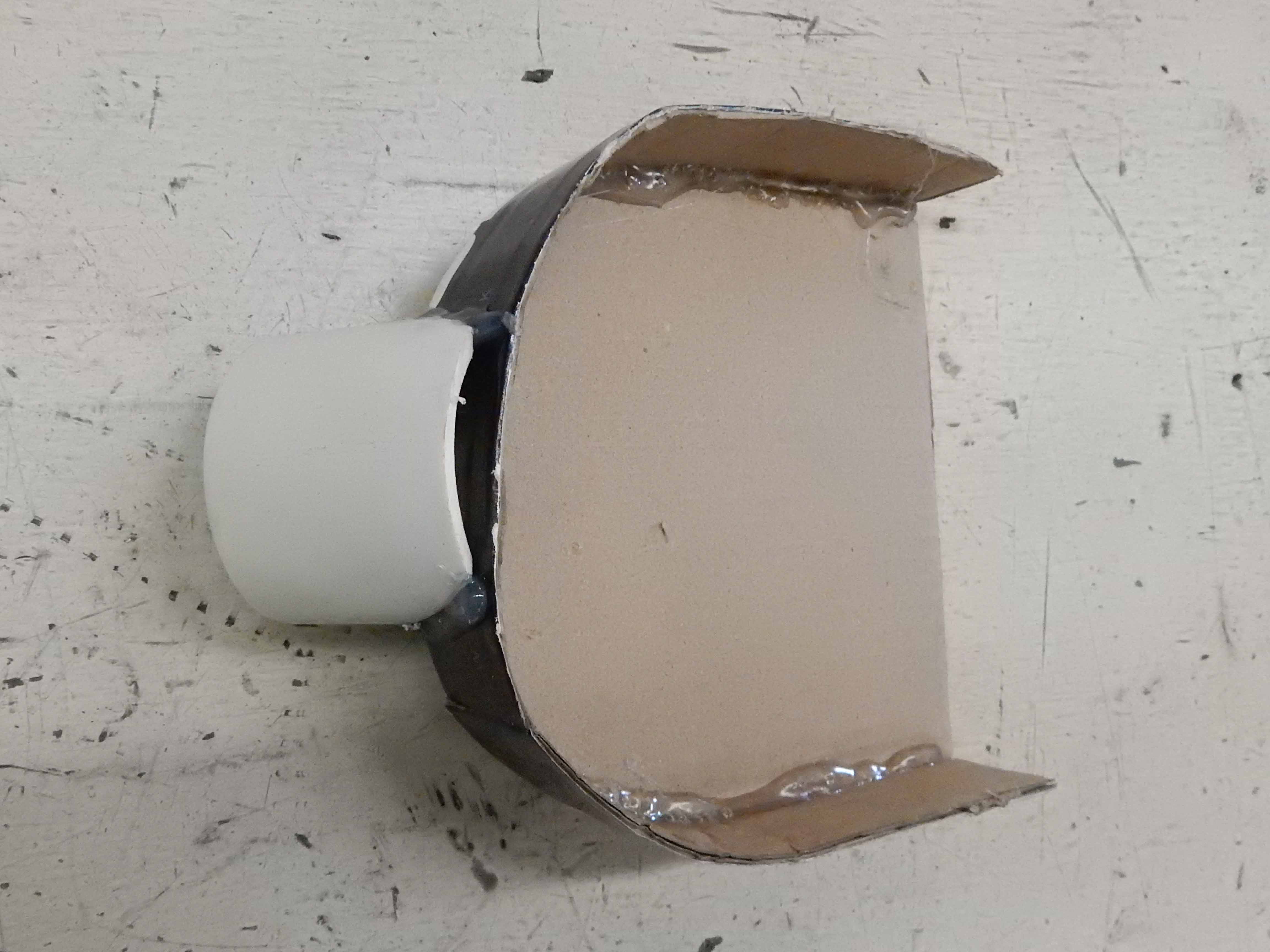 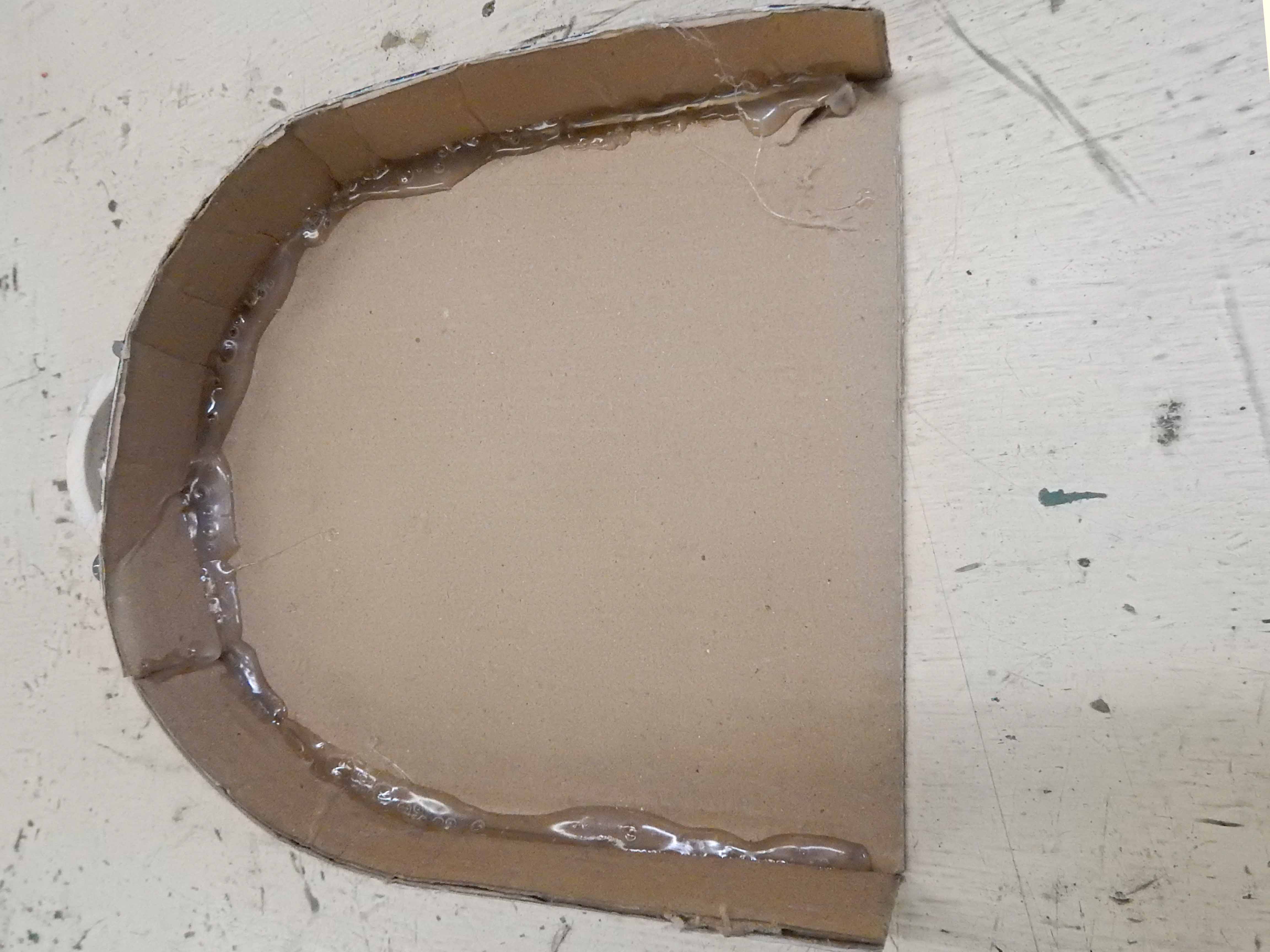
Gary, AKA "Gary fellow": Profile
Dad's: '81 F150 Ranger XLT 4x4: Down for restomod: Full-roller "stroked 351M" w/Trick Flow heads & intake, EEC-V SEFI/E4OD/3.50 gears w/Kevlar clutches
|
Re: Concerning Conversation With DB Electrical
|
Administrator
|
In reply to this post by Gary Lewis
What I was doing is looking at where the various water and oil passages are in relation to the block and head. Sort of like putting a pair of 351C heads on a Windsor block. The bolt holes are all there in the right places, but the water flow is way different.
One of the initial issues is head alignment to the block, being an OHC setup, the head has to be positioned so the cams are parallel to the crank or the drive belt will try to "walk" one way or the other on the cam sprockets. On the 2.2 & 2.5L this is done with 2 small dowels one at each end on the head centered front to rear on the block. The flywheel end hole is a snug fit in the head, the belt end has a small slot allowing for tolerances and the different expansion rates of aluminum and cast iron. On the 2.4L the dowels are hollow and are installed like Ford does, around 2 of the head bolt holes, left front and right rear. Keep those locations in mind. In my case I also have oil supply as the engines are OHC, not pushrod and oil drains back into the crankcase so the head doesn't fill up with oil. First obvious issue is the oil supply location, on the SOHC 2.2 & 2.5L the oil feed to the head, after passing through a restrictor comes to the top of the block near the left front head bolt and goes up past the bolt to the gallery in the head. This runs the full length of the head under the lash adjuster bores and has 5 small passages to the cam bearing towers. On slider cams (non roller followers) there are squirt holes at the cam bearings to spray oil on the cam lobes and followers, the roller cams just depend on the oil thrown off the cam. On the 2.0L and 2.4L the oil feed to the head comes up near the left rear bolt hole, then again through a restrictor and up to a cross passage at the "rear" of the head. This cross passage connects both side oil galleries, one passing down each side of the head with the lash adjusters in it and feeds to all 5 of each camshaft's bearings. There is the first problem, the oil feed is moved to the back side of the engine from the front side. If I can get a clear feed into the left front bolt hole, extending the cross passage to that hole should be no problem. Now comes the other issue, getting this oil back down to the oil pan. The SOHC head used on the 2.2 & 2.5L has a slanted surface as all the ports go out the to the back side of the head and there are 3 large holes in the front that go down into the crankcase for oil drains. On the DOHC head, there is a floor between the cam, lash adjusters and followers, there are 4 oil drain holes, 3 on the back side behind the 3 center rear head bolts and 1 on the front slightly to the left of the 4th bolt from the belt end of the head. One of the issues is the location of the drain holes. The front hole in the DOHC head is close to the furthest left hole in the front side of the block, but the primary drains do not exist in the 2.2 nor 2.5L blocks. If the holes are exposed to where a piece of tubing can be pressed into the head and a suitable drain to the crankcase made. A lot of these "hybrid" 16 valve conversions end up with one or more drain lines off the ends of the central floor. The back one isn't too bad, but a front one has to clear the timing belt. Now onto the ignition, the 2.2 & 2.5L engines, with the exception of the rare turbo III DOHC engines use a distributor that contains a pair of Hall effect pickups and a shutter similar to the Ford TFI distributor. Ford uses one narrow vane to reference #1 cylinder, Chrysler uses a vane with a hole in it giving a double pulse to reference #1. The T III engines use a crank trigger at the flywheel that senses a hole for cylinders 1 & 4 and 2 & 3 the engine computer then uses this and it's frequency to determine where to fire the two coils on the top of the engine, one of the issues with these engines is the lack of a cam sensor and the oil pump drive being at 3/4 crank speed which puts a lot of stress on the intermediate shaft to oil pump drive gears which can fail catastrophically resulting in a destroyed engine. 2.0 and 2.4L engines use a DIS system with two coils but it is triggered by a partial target on the crank and one on the intake cam. The computer takes these signals to determine when to fire the coils. The conversions typically retain the distributor and run the plug wires up through the intake manifold between number 2 & 3 runners. I may try to do something similar to the DIS system if I can figure or find out a good way to trigger the system. I do have a Ford 35 & 1 trigger wheel along with the cam sensor for the head.
Bill AKA "LOBO" Profile
"Getting old is inevitable, growing up is optional" Darth Vader 1986 F350 460 converted to MAF/SEFI, E4OD 12X3 1/2 rear brakes, traction loc 3:55 gear, 160 amp 3G alternator Wife's 2011 Flex Limited Daily Driver 2009 Flex Limited with factory tow package Project car 1986 Chrysler LeBaron convertible 2.2L Turbo II, modified A413 |
Re: Concerning Conversation With DB Electrical
|
Administrator
|
In reply to this post by Gary Lewis
Concept looks good, From what I remember the fans are on both ends of the rotor and the primary intake is through the front of the case. The diodes and regulator are on the back of the alternator where there doesn't seem to be much air circulation.
A thought, unfortunately it will add some more current load to the alternator. On the first run of EFI 300s Ford found that the heat soak on the fuel rail was enough to boil the gas when sitting hot and shut off. The quick fix was a small blower and a duct with holes in it to blow air over the fuel injectors. It was controlled by a thermal switch on the fuel rail that closes a relay that has power at all times so that when the thermal switch closes the fan is turned on and air is blown across the injectors. Fan is only fused at 15 amps so it isn't a big draw. Two thoughts on it (a) if you duct the air to the back side of the alternator, the wires can be run down a piece of defroster hose, like Mercedes did, (b) the fan can draw air from a cooler area, like the cowl or even under a front fender like Ford did with the MEL engines. From the cowl would push cooler air through the alternator when driving even if the fan weren't running.
Bill AKA "LOBO" Profile
"Getting old is inevitable, growing up is optional" Darth Vader 1986 F350 460 converted to MAF/SEFI, E4OD 12X3 1/2 rear brakes, traction loc 3:55 gear, 160 amp 3G alternator Wife's 2011 Flex Limited Daily Driver 2009 Flex Limited with factory tow package Project car 1986 Chrysler LeBaron convertible 2.2L Turbo II, modified A413 |
|
In reply to this post by Gary Lewis
2.5 second that is interesting, I could never find a time for my GR-818 outside of an Amazon listing that cites this regulator is a 10 second load response control which I take to mean 10 second LRC, and it states it is similar to the 36-6004 except 36-6004 w/o LRC and the 36-6008 w/ LRC 2.5 Second. I really need to devise a way to test and verify that this is a 10 second response cause I am curious if it just delays for 10 seconds if it really is 10 seconds or if it does like I think it does which is slowly ramp the output up over 10 seconds which would be great for me with my single V belt. I'd be curious to see what you come up with on the duct work. I dont know if I will need to do that, I seem to recall my 1G alternator sits out to the side of the opening of my fan shroud so it shouldnt get any air from the radiator blowing directly on it. Its also interesting that you have a lot of heat coming off your radiator with a 180* thermostat, I wonder if its because I have a smaller 302 with the HD cooling that keeps the coolant more or less close to or at the set point. I am curious though to see how much more air flow I have with my upgrade from the OE 5 blade flex fan to a almost OE spec 7 blade flex fan. Im hopeful that coupled with my OE HD cooling radiator will keep my little built up 302 cooled. I didnt know you were planning on upgrading to a 220A 3G alternator. Im trying to keep from talking myself from the 130A 3G down to the 95A 3G due to only being able to run one V belt lol.
"Old Blue" - '56 Fairlane Town Sedan - 292-4V, Ford-O-Matic transmission, 3.22:1
'63 Belair 2dr sdn - 283-4V, Powerglide transmission, 4.56:1 '78 Cougar XR7 - 351-2V, FMX transmission, 2.75:1 9inch "Bruno" - '82 F150 Flareside - 302-2V, C6 transmission, 2.75:1 9inch, 31x10.50-15 BFG KO2 |
| Edit this page |


